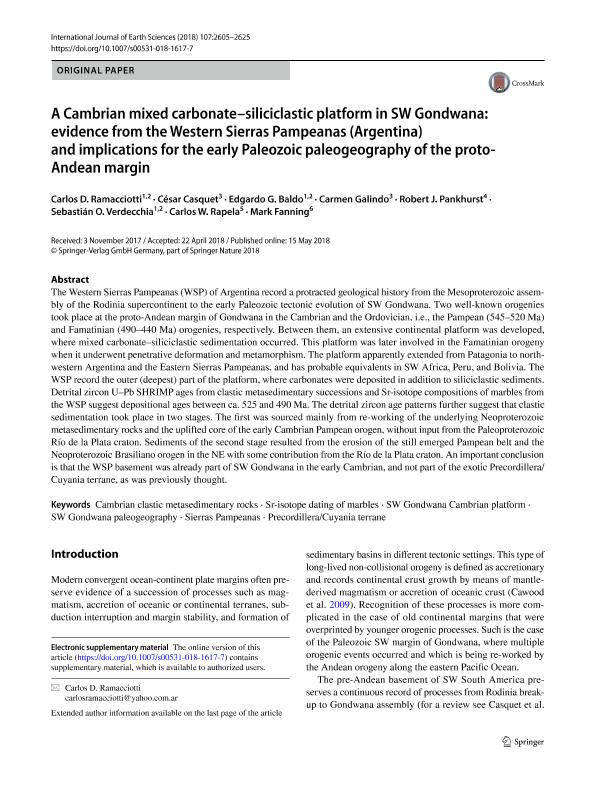Mostrar el registro sencillo del ítem
dc.contributor.author
Ramacciotti, Carlos Dino

dc.contributor.author
Casquet, César

dc.contributor.author
Baldo, Edgardo Gaspar Agustin

dc.contributor.author
Galindo Francisco, Carmen

dc.contributor.author
Pankhurst, Robert

dc.contributor.author
Verdecchia, Sebastián Osvaldo

dc.contributor.author
Rapela, Carlos Washington

dc.contributor.author
Fanning, Christopher Mark

dc.date.available
2021-04-08T19:35:37Z
dc.date.issued
2018-10
dc.identifier.citation
Ramacciotti, Carlos Dino; Casquet, César; Baldo, Edgardo Gaspar Agustin; Galindo Francisco, Carmen; Pankhurst, Robert; et al.; A cambrian mixed carbonate–siliciclastic platform in SW Gondwana: Evidence from the Western Sierras Pampeanas (Argentina) and implications for the early Paleozoic paleogeography of the proto-Andean margin; Springer; International Journal of Earth Sciences; 107; 7; 10-2018; 2605-2625
dc.identifier.issn
1437-3254
dc.identifier.uri
http://hdl.handle.net/11336/129654
dc.description.abstract
The Western Sierras Pampeanas (WSP) of Argentina record a protracted geological history from the Mesoproterozoic assembly of the Rodinia supercontinent to the early Paleozoic tectonic evolution of SW Gondwana. Two well-known orogenies took place at the proto-Andean margin of Gondwana in the Cambrian and the Ordovician, i.e., the Pampean (545–520 Ma) and Famatinian (490–440 Ma) orogenies, respectively. Between them, an extensive continental platform was developed, where mixed carbonate–siliciclastic sedimentation occurred. This platform was later involved in the Famatinian orogeny when it underwent penetrative deformation and metamorphism. The platform apparently extended from Patagonia to northwestern Argentina and the Eastern Sierras Pampeanas, and has probable equivalents in SW Africa, Peru, and Bolivia. The WSP record the outer (deepest) part of the platform, where carbonates were deposited in addition to siliciclastic sediments. Detrital zircon U–Pb SHRIMP ages from clastic metasedimentary successions and Sr-isotope compositions of marbles from the WSP suggest depositional ages between ca. 525 and 490 Ma. The detrital zircon age patterns further suggest that clastic sedimentation took place in two stages. The first was sourced mainly from re-working of the underlying Neoproterozoic metasedimentary rocks and the uplifted core of the early Cambrian Pampean orogen, without input from the Paleoproterozoic Río de la Plata craton. Sediments of the second stage resulted from the erosion of the still emerged Pampean belt and the Neoproterozoic Brasiliano orogen in the NE with some contribution from the Río de la Plata craton. An important conclusion is that the WSP basement was already part of SW Gondwana in the early Cambrian, and not part of the exotic Precordillera/Cuyania terrane, as was previously thought.
dc.format
application/pdf
dc.language.iso
eng
dc.publisher
Springer

dc.rights
info:eu-repo/semantics/openAccess
dc.rights.uri
https://creativecommons.org/licenses/by-nc-sa/2.5/ar/
dc.subject
CAMBRIAN CLASTIC METASEDIMENTARY ROCKS
dc.subject
PRECORDILLERA/CUYANIA TERRANE
dc.subject
SIERRAS PAMPEANAS
dc.subject
SR-ISOTOPE DATING OF MARBLES
dc.subject
SW GONDWANA CAMBRIAN PLATFORM
dc.subject
SW GONDWANA PALEOGEOGRAPHY
dc.subject.classification
Geología

dc.subject.classification
Ciencias de la Tierra y relacionadas con el Medio Ambiente

dc.subject.classification
CIENCIAS NATURALES Y EXACTAS

dc.title
A cambrian mixed carbonate–siliciclastic platform in SW Gondwana: Evidence from the Western Sierras Pampeanas (Argentina) and implications for the early Paleozoic paleogeography of the proto-Andean margin
dc.type
info:eu-repo/semantics/article
dc.type
info:ar-repo/semantics/artículo
dc.type
info:eu-repo/semantics/publishedVersion
dc.date.updated
2021-03-26T19:36:03Z
dc.identifier.eissn
1437-3262
dc.journal.volume
107
dc.journal.number
7
dc.journal.pagination
2605-2625
dc.journal.pais
Alemania

dc.description.fil
Fil: Ramacciotti, Carlos Dino. Consejo Nacional de Investigaciones Científicas y Técnicas. Centro Científico Tecnológico Conicet - Córdoba. Centro de Investigaciones en Ciencias de la Tierra. Universidad Nacional de Córdoba. Facultad de Ciencias Exactas Físicas y Naturales. Centro de Investigaciones en Ciencias de la Tierra; Argentina
dc.description.fil
Fil: Casquet, César. Universidad Complutense de Madrid; España
dc.description.fil
Fil: Baldo, Edgardo Gaspar Agustin. Consejo Nacional de Investigaciones Científicas y Técnicas. Centro Científico Tecnológico Conicet - Córdoba. Centro de Investigaciones en Ciencias de la Tierra. Universidad Nacional de Córdoba. Facultad de Ciencias Exactas Físicas y Naturales. Centro de Investigaciones en Ciencias de la Tierra; Argentina
dc.description.fil
Fil: Galindo Francisco, Carmen. Universidad Complutense de Madrid; España
dc.description.fil
Fil: Pankhurst, Robert. British Geological Survey; Reino Unido
dc.description.fil
Fil: Verdecchia, Sebastián Osvaldo. Consejo Nacional de Investigaciones Científicas y Técnicas. Centro Científico Tecnológico Conicet - Córdoba. Centro de Investigaciones en Ciencias de la Tierra. Universidad Nacional de Córdoba. Facultad de Ciencias Exactas Físicas y Naturales. Centro de Investigaciones en Ciencias de la Tierra; Argentina
dc.description.fil
Fil: Rapela, Carlos Washington. Consejo Nacional de Investigaciones Científicas y Técnicas. Centro Científico Tecnológico Conicet - La Plata. Centro de Investigaciones Geológicas. Universidad Nacional de La Plata. Facultad de Ciencias Naturales y Museo. Centro de Investigaciones Geológicas; Argentina
dc.description.fil
Fil: Fanning, Christopher Mark. Australian National University; Australia
dc.journal.title
International Journal of Earth Sciences

dc.relation.alternativeid
info:eu-repo/semantics/altIdentifier/url/http://link.springer.com/10.1007/s00531-018-1617-7
dc.relation.alternativeid
info:eu-repo/semantics/altIdentifier/doi/http://dx.doi.org/10.1007/s00531-018-1617-7
Archivos asociados
